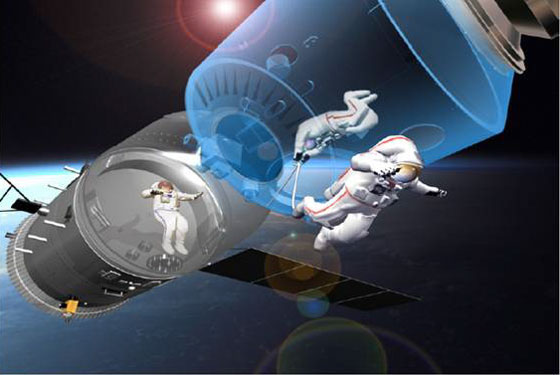China's First Spacewalk: A Prelude of Things to Come

GOLDEN,Colo. — China is stepping up and out in the world of space exploration.
Spaceofficials in that country are readying the Shenzhou 7spacecraft for an October sendoff, one that will carry a trio of their ?taikonauts?into Earth orbit. The mission not only promises to strengthen China?s humanspace travel agenda, but also provides a glimpse into actions to be undertakenin the future.
China hasinitiated a step-by-step approach in flying their taikonauts: The single-person Shenzhou 5 flightin 2003 of 14 orbits; the two-person voyage of Shenzhou 6 in 2005 lasting 5days; and soon to head skyward, a threesome of space travelers. And on thisflight, one of those space travelers is to carry out China?sfirst spacewalk, also known as extravehicular activity, or EVA for short.
In someways, the upcoming mission spotlights the hop, skip, and jump abilities ofChina in comparison to U.S. space history.
For the U.S.,the Mercury series of single-seat flights led to the two-person missions ofGemini spacecraft, followed by sojourns of the Apollo three-person crewcapsule. More to the point, in the U.S., the first human-carrying orbitalflight of Mercury was in 1962; Gemini in 1965; and Apollo in 1968.
So is therea true measure of growth, albeit somewhat skewed given the driving nature ofthe Soviet Union versus the U.S. ?Moon race??
Case inpoint: If this next mission for China is successful in attaining orbit, thatcountry will have taken something like a year less time to move fromsingle-seat orbital flight to Apollo three-seat space travel - contrasted toU.S. human spaceflight progress in Earth orbit.
Breaking space news, the latest updates on rocket launches, skywatching events and more!
Learningcurve
On onehand, China?ssteadfast evolution in human space treks is laudable. On the other, giventhat status card, leading spaceflight aficionados seem to sense differenttake-home messages.
?Implications, as far as I cansee...few, if any,? said Joan Johnson-Freese, an analyst of China?s space policy and Chair of theNational Security Decision-Making Department at the U.S. Naval War College inNewport, R.I.
Johnson-Freesetold SPACE.com that the U.S. Mercury program of the 1960s wasspearheading research just to see if humans could swallow in space?or how thehuman psyche would react once in Earth orbit. There were lots of medicalquestions, she noted.
NASA?sProject Mercury was quickly followed by a salvo of 10 human-carrying Geminiflights from March 1965 to November 1966. All-in-all, piloted Mercury andGemini orbital outings tally up to 14 flights in five years, Johnson-Freeseobserved — and don?t forget those two earlier and piloted suborbital Mercurymissions.
?Technology development wasincremental because it was all new, but consistent,? Johnson-Freese stressed.
?TheChinese will have three flights with a successful mission next fall. They have beenable to benefit from lots of lessons learned from both the Americans and theRussians. That is not to downplay the difficulty of the technology or theachievements of the Chinese?they just have the luxury of starting much higheron the learning curve,? she concluded.
Pow?pow?pow
Given theyears of mastering human space travel, is China?s blossoming to-do list inorder to operate in Earth orbit worth spotlighting?
?Yes,absolutely?it is worth flagging,? said Dean Cheng, an Asian affairs specialist at the U.S.-basedCenter for Naval Analysis in Alexandria, Virginia.
?Now, theflip side to that, of course, is that it has also been done before. So it?s notlike they need to engineer everything from scratch,? Cheng told SPACE.com,adding that China can depend on designs similar to those proven to work by theU.S. and former Russians. ?But, yes, it is nonetheless impressive.?
Chengpoints out, however: ?The main difference ?there were more Mercury and Geminiflights in the intervening period. What is interesting about the Chinese effortis that they are doing it with so few flights. Four unmanned flights?thenpow-pow- pow?one-man, two-man, three-man/EVA.?
Cheng alsounderscored the built-in danger to nations that ramp up human spaceflightexpertise. Both the U.S. and the Soviet Union lost people during theirrespective run-ups.
?You haveto wonder if the Chinese can sustain a perfect space record,? he added. ?Obviously,one hope?s that they can.?
Take-awayknowledge
In terms ofwhere China is really headed in human spaceflight, crystal ball gazing is not easy.
Stacking uptheir one-two-three punch in the field of human spaceflight against U.S. spaceprogram heritage doesn?t quite match up, said Roger Launius, senior curator forthe Division of Space History at the Smithsonian Institution?s National Air andSpace Museum in Washington, D.C.
?Learningwhat China needs to know about conducting a lunar trip, probably a circumlunartrip, on three missions seems a bit thin to me,? Launius told SPACE.com.
WhileMercury, Gemini, and Apollo programs might have been exceptionally cautious — and thus took more time and a greater number of missions than the Chineseeffort — the knowledge return from the American programs versus China?s threeflights cannot be anywhere near each other, Launius explained.
?Let?s takethe Gemini program,? Launius said. ?A central reason for it was to perfecttechniques for rendezvous and docking, EVA, and long duration flight. Assumingthat these same skills will be required in a Chinese moon program, and Ibelieve they will, where will the knowledge and experience for them come fromin these three missions??
Launiussaid that the Gemini flights swamp China in terms of demonstrated skills. Thecountry has yet to rack up the experience base of spacewalking, rendezvous anddocking that is now standard in the U.S. and Russia, he added.
??A corequestion, it seems to me, is this: ?Will ground simulation be able tocompensate for the lack of orbital experience?? Launius said. ?Perhaps, but I?mnot sure.?
Moreacclaim than deserved?
Steppingback and taking a larger look at where China?s human space program is headed,Launius observed: ?Personally, I think the Chinese program is moving forward ata modest pace and is getting a lot of mileage out of the fact that it is asecret effort that forces us to speculate about it. It is receiving among thespace community more acclaim than I think it deserves.?
Launiussaid that there?s enough in China?s statements on future manned moon missions tofuel Western speculation that the country has a vast program, immenselycapable, and seeking to at least equal the Americans in a Moon program of itsown.
?There isno official Chinese evidence to support the concept of a Chinese human moonprogram, despite the wishes of some inside the Chinese space program who wouldlove to do it. Occasionally, someone will say something about this to Westernmedia but official documents available do not say anything about such aprogram,? Launius said.
There arethose in the U.S. space community that would like to see China hell-bent on sendingtaikonauts onto the moon?s surface, Launius said, because they believe it wouldspark a new space race. ?I?m not sure that would be the outcome of theseChinese efforts?but I also see no evidence for serious Chinese efforts in thatdirection,? he added.
Pickingup speed
Meanwhile,preparations to launch Shenzhou 7 are picking up speed in China.
Accordingto Chinese news services, the spacecraft has undergone modifications to accommodate anairlock. A spacewalking-qualified space suit has been okayed for flight.There have been extensive checkouts of the craft to fulfill its missionobjectives.
What daythe three-person crew takes off from the Jiuquan Satellite Launch Center on itsLong March booster in October is yet to be announced. Earlier, there has beencomment about broadcasting the spacewalk live on television.
Moreover, thespacewalk mission — and the duties to be performed during the EVA — has beendeemed as crucial for China to make possible a space laboratory or station inEarth orbit.
Earlierthis month, it was noted that six taikonauts had been selected for the upcomingmission from 14 candidates — a crowd that included Yang Liwei, China?sfirst space explorer who flew solo on Shenzhou 5. For Shenzhou 7, threewill fly the actual mission with the others tagged as substitutes.
Also,Yuanwang 6, an ocean-going tracking ship, has been delivered for service inShanghai to participate in the Shenzhou 7 flight and to assist in the slatedspacewalk. It joins sister ship, Yuanwang 5, to take part in maritime spacesurveying and mission controlling operations.
Qi Faren,academician of the Chinese Academy of Engineering and researcher of ChinaSpaceflight Technology Research Institute — credited as chief designer ofChina?s first five Shenzhou spaceships and chief consultant for Shenzhou 6 andShenzhou 7 - has been quoted as saying that plans are already underway forShenzhou 8 and Shenzhou 9. He added that ?the intervals between each launchwill become shorter.?
- VIDEO: Shuttle Discovery's Space Station Fly Around
- Shenzhou Rising: China?s Second Manned Spaceflight
- Special Report: Emerging China, Engaging China
Join our Space Forums to keep talking space on the latest missions, night sky and more! And if you have a news tip, correction or comment, let us know at: community@space.com.

Leonard David is an award-winning space journalist who has been reporting on space activities for more than 50 years. Currently writing as Space.com's Space Insider Columnist among his other projects, Leonard has authored numerous books on space exploration, Mars missions and more, with his latest being "Moon Rush: The New Space Race" published in 2019 by National Geographic. He also wrote "Mars: Our Future on the Red Planet" released in 2016 by National Geographic. Leonard has served as a correspondent for SpaceNews, Scientific American and Aerospace America for the AIAA. He has received many awards, including the first Ordway Award for Sustained Excellence in Spaceflight History in 2015 at the AAS Wernher von Braun Memorial Symposium. You can find out Leonard's latest project at his website and on Twitter.
